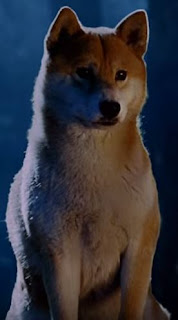A long, long time ago an old man and his wife lived in a remote corner of Japan. They had no children and were a little lonely. Every day the man gathered firewood in the mountains and his wife washed clothes in a nearby stream. One day, as the old woman was doing her washing, an enormous peach came bobbing downstream. She picked it up with difficulty - it was so big and heavy - and took it home.
The old woman waited for her husband to come home before eating the peach. When he had arrived, she took out a knife and plunged into the juicy peach, exclaiming, "What a tasty treat!" At that very moment, the peach split in two and with a loud wail out sprang a sweet boy. At first the couple was startled; then overjoyed at having been blessed with a child. They called him Momotaro (momo means peach; Taro is a common Japanese boys' name) and brought him up with tender loving care.
Momotaro grew up strong, powerful, and kind. In no time at all he had become the strongest in the village. One day Momotaro heard about the ogres on Onigashima (Ogres' Island) who spread fear among his countrymen. He begged the old man and woman to allow him go to Onigashima to drive away the ogres. At first they were surprised and worried but Momotaro insisted so earnestly that they finally gave in to his plea. They prepared some millet dumplings for Momotaro to eat on his journey and saw him off.

Momotaro set off in high spirits. At the edge of the village he met a dog. "Momotaro, where are you going? What are you carrying in that bag?" asked the dog. "I'm off to Onigashima," replied Momotaro, "and I'm carrying the most delicious millet dumplings in all Japan. If you help me drive away the ogres I'll give you one." The hungry dog gobbled down a dumpling and became Momotaro's steadfast companion. Soon they came across a pheasant. In return for a tasty dumpling, the pheasant also agreed to join Momotaro's party. Next they met a monkey who was also persuaded to join them in exchange for a millet dumpling.

When Momotaro's party finally reached Onigashima, they found a large gate blocking their way. The pheasant flew over it and unlocked it from inside. The party passed through and were met by a strange spectacle. The ogres were in the midst of merrymaking. "We've come to punish you for plaguing my countrymen!" bellowed Momotaro and charged towards the drunken ogres with his three animal friends. The pheasant pecked the ogres all over, the monkey pounced and scratched them, and the dog bit their arms and legs. Thanks to having eaten the best millet dumplings in Japan, Momotaro's party had the strength of a thousand people and had the ogres running for their lives.

Completely overpowered, the defeated leader of the ogres dropped to his knees before Momotaro. With tears streaming down his face he said, "I promise we will never trouble human beings again, and we will return all the treasures we have ever taken from your village. But please spare our lives! I beseech you!" Thereupon, Momotaro loaded the treasures onto a boat and joined by his small but feisty party headed back home with it in triumph.
THE END




















